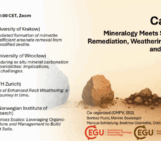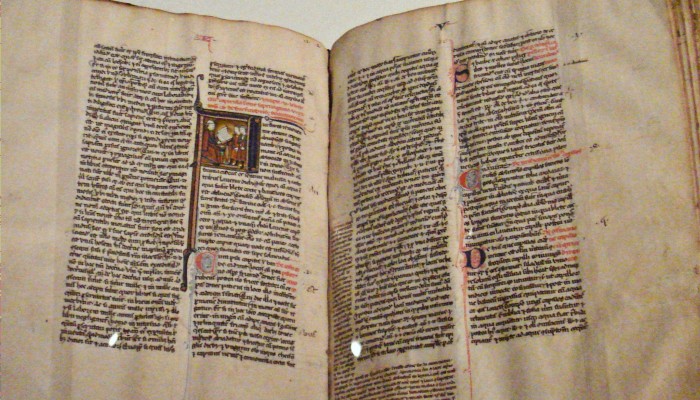
Like many scientists in the GMPV sphere, I work a lot with geochemistry – using chemical elements and their differing behaviours, abundances or isotopes as tools to understand Earth processes. While staring at the periodic table, something that’s always niggled at me is where the names of these come from: why is the stuff we breath called oxygen and the sand on the beach made of silicon? Even more puzzling to me has always been those cases where the element name in English doesn’t match its symbol. Okay I guess someone told me lead is Pb because of its latin name, but what about K, or Sb?? I’ve always found this deeply mystifying, but somehow never got round to finding out.
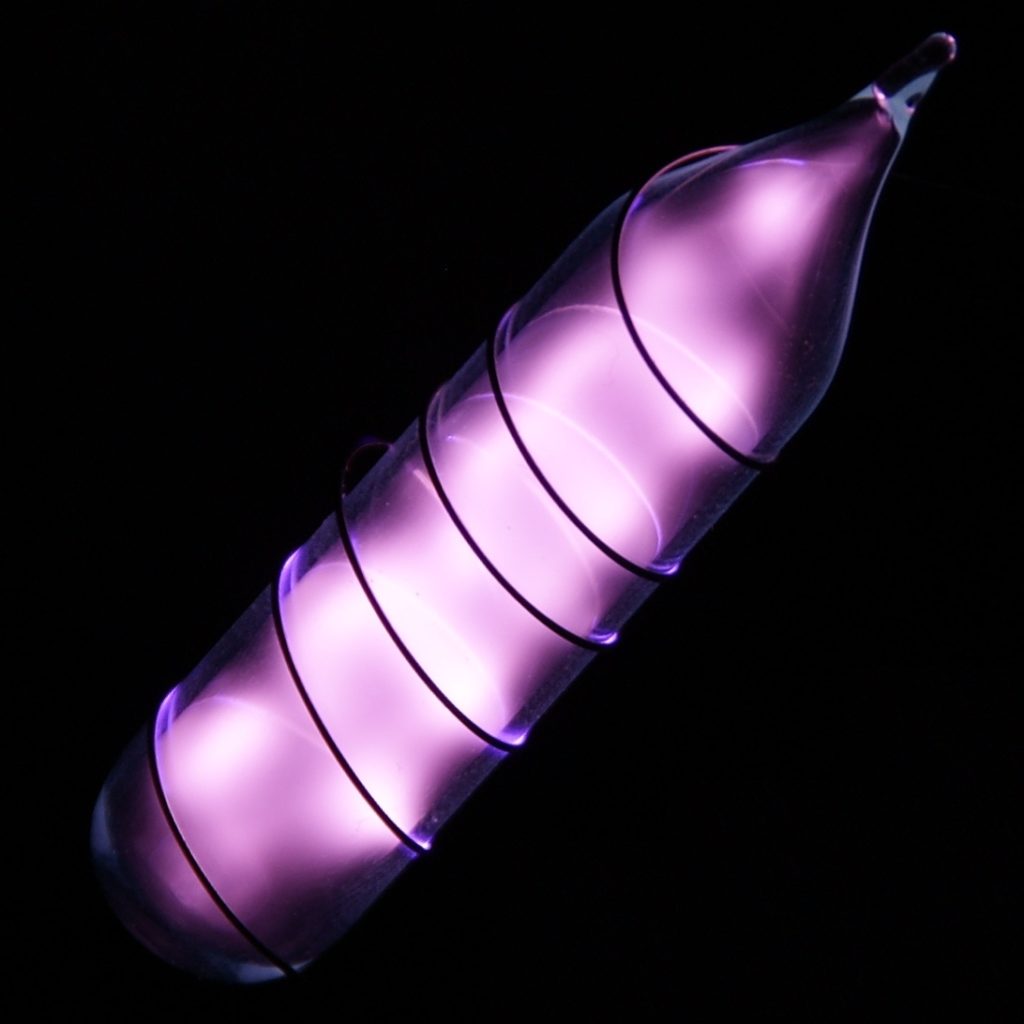
Vial of glowing ultrapure helium. Helium is named for the sun (Greek helios) where it was first discovered as an unknown emission line in the spectrum of the Sun’s chronosphere. By Jurii, CC BY 3.0, via Wikimedia Commons.
The idea from this blog really came by chance when I was listening to an episode of the history of English Podcast, a really excellent series charting the history of the English language. The episode gave me a great answer to the potassium question which I thought I’d share here. There is a link to the episode at the bottom and I highly recommend anyone interested to check it out as it’s really fascinating.
Now as an overall introduction (note that sources for much of this blog come from scholarly journal Wikipedia), elements are mostly named for one of: mythical or astronomical concepts (like helium for the sun); people (like einsteinium); places on Earth (like europium) or minerals or substances they are found in (like potassium from potash). There are also a few typical suffixes which are mostly derived from an early-discovered element and have been propagated to similar more recently discovered elements. These include -ium for metals, -on for non-metals, -ine for halogens, and -gen for gases forming diatomic molecules (H2, N2, O2).
Of course, going through the source of the names for every element would be a bit much for a short blog and not necessarily what you wanna skim on a coffee break. So, in the interests of brevity we’ll just look at a couple of interesting stories of elemental etymology.
Alchemy, chemistry and Arabic science
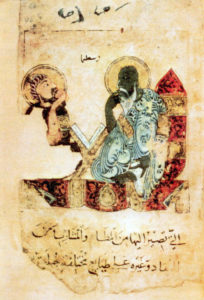
A medieval Arabic representation of Aristotle teaching a student. From Seyyed Hossein Nasr, Islamic Science: An Illustrated Study, Public Domain via Wikimedia Commons.
As alluded to above, the element potassium is named after potash, a substance rich in potassium salts originally made by mixing plant ash with water rich in potassium. However, if you check your periodic table you’ll notice that potassium has the chemical symbol K. So why is that? Well for the answer we need to go back to the early history of science and chemistry. The early roots of chemistry are in alchemy – attempts to transmute gold and silver from base metals, produce elixirs of life and find panaceas which could cure any illnesses – and for much of history chemistry was indistinguishable from proto-scientific alchemy.
Now following the fall of Rome came what has been termed (and challenged) the Dark Ages in Europe. Exactly how dark they were is subject to debate, but what is less disputed is that much of the classical knowledge of the ancient Romans and Greeks was lost in Europe but survived and was built on in the east, including in the Arab world, before the reintroduction of this knowledge to Europe as part of the 12th Century Renaissance (one of several Medieval Renaissances which preceded the 15th and 16th Century artistic, philosophical and cultural revival most commonly referred to as The Renaissance).
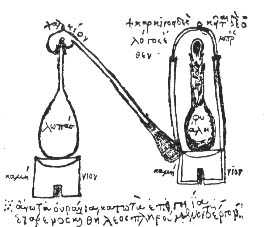
Medieval depiction of alchemical apparatus: Ambix, cucurbit and retort of Zosimos, from Marcelin Berthelot, Collection des Anciens Alchimistes Grecs, Public Domain via Wikimedia Commons.
Returning to the preceding paragraph above, we can see this Arabic influence in many of the words associated with alchemy and science. Like many Arabic loan words in English, these are often distinguished by the Arabic definite article al, meaning “the”, which often wasn’t recognised as a separate word by later English speakers. In this way, elixir has its origins in Arabic as al-iksir, algebra as aj-Jebr and even the work of alchemy itself, as al-kimiya. This latter term is said to have originated as an old Greek name for Egypt (khēmeía) where earlier attempts at alchemy had taken place so, in this interpretation, alchemy literally means “the Egyptian Art”. Most importantly for this story, we also got another word from this period of Arabic science: al-qaliy or, in modern English, alkali. This was the Arabic term for plant ashes or potash and gave its name to the substance. The article al was sometimes dropped and the word passed into latin as kalium and (possibly via German) gave us the K symbol for potassium. So, remarkably, both potassium and K have the same root meaning of plant ash, one reaching us via English and the other via Arabic.
A rare find

Ytterby mine in Resarö, Sweden, circa 1910. Image courtesy of the Tekniska Museet, Stockholm via Flickr CC BY 2.0
Now another common way to name elements is after a place. These run from the mundane, (americium, germanium and californium are all pretty clear in their origins) to the celestial (e.g. uranium, neptunium, plutonium), but only one place has the honour of having four different elements named after it. That is the village of Ytterby on the Swedish island of Resarö. Those of you who work a lot with rare-earth elements are probably already connecting the dots of which elements these are – yttrium (Y), terbium (Tb), erbium (Er), and ytterbium (Yb) – and if you’ve ever struggled to remember which is which, now you know why they are so similarly named.
When I first heard this fact I thought that perhaps there was a chemistry research facility there which specialised in isolating new elements but actually the village is very small with only around 3000 inhabitants. The actual reason for its many chemical namesakes is the presence of a pegmatitic dyke which was mined for quartz and feldspar from the 1600s right up until 1933. In the late 18th Century a Swedish army officer and amateur geologist named Carl Arrhenius (not to be confused with the famous chemist Svante Arrhenius) noticed an unusually heavy, unidentified black mineral.
This was eventually analysed in 1794 by Finnish chemist Johan Gadolin who found that a large proportion of the mineral was made up of a new and then unknown element. This was eventually named yttrium and the mineral gadolinite. Many elements were discovered from this new mineral including the four named after Ytterby, as well as scandium (Sc) and thulium (Tm). In 1880, one more elemental discovery took place which can be traced to the Ytterby mine. This was gadolinium (Gd) which took the name of the mineral, gadolinite, and ultimately the name of the chemist who first worked on this remarkable rare-earth mineral.
So from Arabic scientists who gave us alchemy, elixirs and algrebra to the sleepy village with an abundance of rare-earth elements, the origins of element names are varied and numerous. Some (including bismuth, Bi, and antimony, Sb) are obscure or disputed and may simply have been forgotten to time. Some, however, lead you down a rabbit-hole of fascinating stories and world history. So now you know why potassium is K on the periodic table and that the origins of this, like chemistry itself, are in the work of Arab alchemists, themselves building on the works of Ancient Greece and Egypt, over 1000 years ago.
Further reading/listening
https://historyofenglishpodcast.com/2017/02/15/episode-90-healers-hospitals-and-holy-wars/
https://en.wikipedia.org/wiki/Islamic_world_contributions_to_Medieval_Europe




